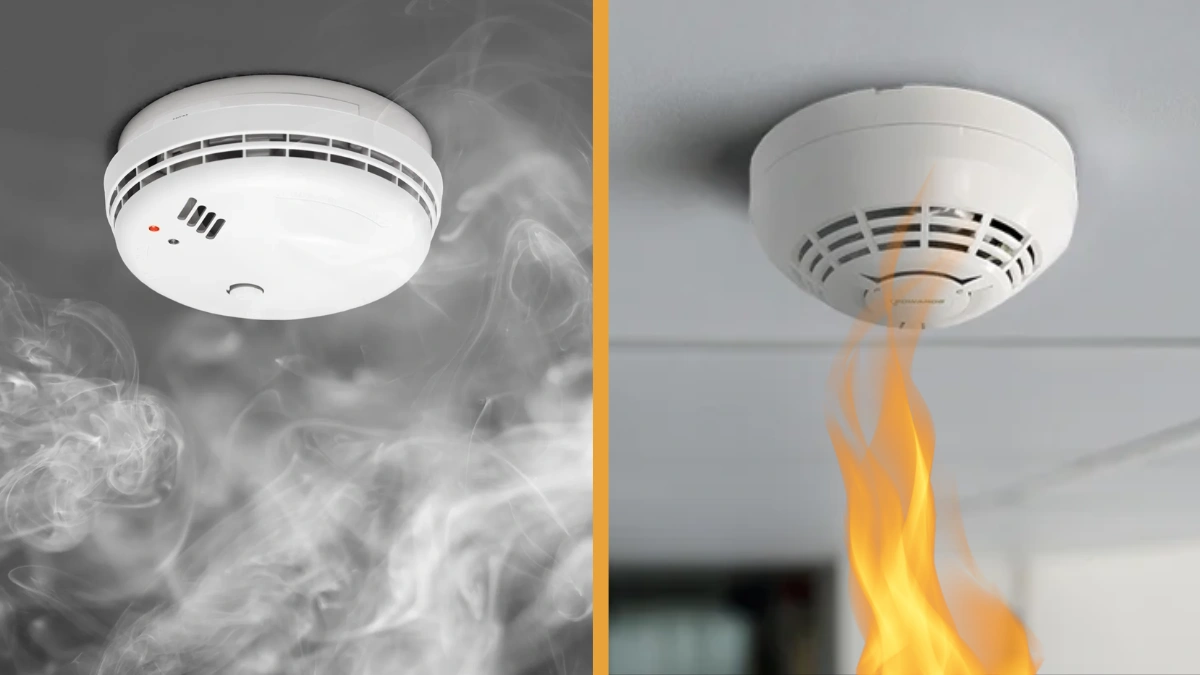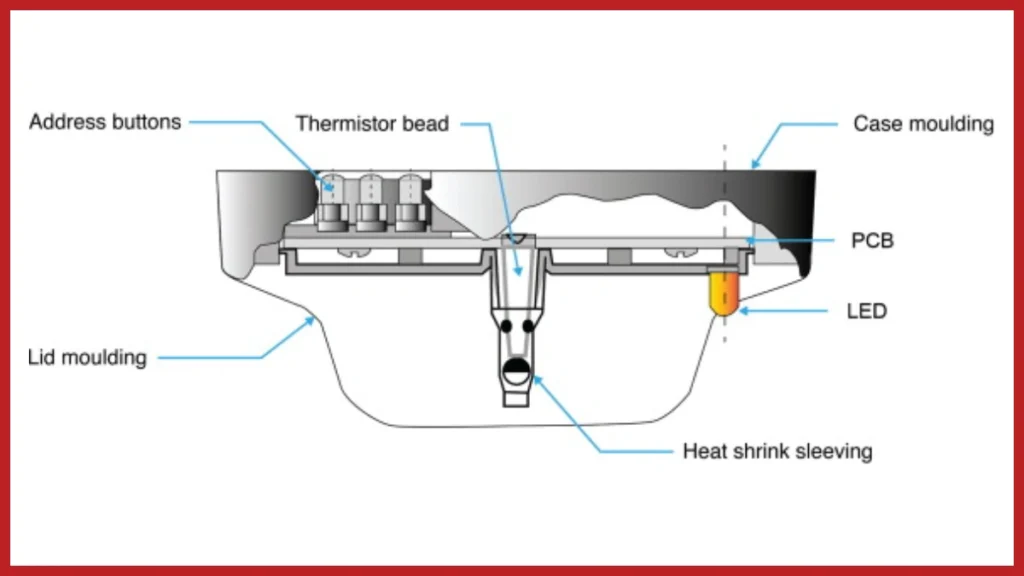Smoke Detectors vs. Heat Detectors: Which One Do You Need

Smoke Detectors vs. Heat Detectors: Which One Do You Need
Every second matters in your fire safety, and having the right detection system in place can be the difference between life and death. Our first line of defense, alarms allow us to signal for help, flee, and avoid major harm. This is where many people are confused, however: should you trust your heat detectors, smoke detectors, or both?
The fact is that there is no one-size-fits-all approach to fire detection. Knowing which detector type to use in every space of your house or place of business is important for creating a reliable safety system. Different detector types have different purposes. Smoke detectors are excellent at detecting the smoke itself, which is an early warning sign.
However, heat detectors flash in areas where smoke alarms are installed. On the other hand, heat detectors are ideal in areas like kitchens and garages, where smoke alarms may not be effective due to the issue of false alarms caused by dust or steam.
The article explains the differences between heat and smoke detectors, describes how each works and provides practical placement guidance. By the finish, you’ll understand precisely how to use the right combination of equipment to protect your house or place of business. After all, planning is the first step towards mental peace.
Smoke Detectors vs. Heat Detectors
Heat detector
A heat detector is a device that senses temperature changes. It goes off when the room temperature rises quickly or reaches a set level. There are two types: fixed temperature heat detectors, which trigger at a specific point like 135°F and are reliable without false alarms, and rate-of-rise heat detectors, which activate when the temperature rises very quickly. Heat detectors don’t detect smoke — they only respond to heat.
Smoke Alarm
A smoke detector is a device that senses smoke in the air and goes off often before you see fire. Ionization smoke detectors detect fast flaming fires using a small amount of radioactive material but may give false alarms near kitchens or bathrooms.
What Is the Difference Between a Heat Alarm and a Smoke Alarm?

Heat and smoke alarms may look similar. Both of these are small devices that affix to your wall or ceiling and can be connected or run on batteries. But their real difference depends on what their purpose is.
- The purpose of smoke alarms is to identify smoke particles. They’re good for early warnings since they detect fire long before flames are seen. Heat alarms are used to detect temperature changes or when the temperature rises over a safe level. They start work when the surroundings get uncomfortably hot, not when they detect smoke.
- This means every device has a specific purpose in terms of fire safety. You have the most time to react when a smoke alarm goes off during the early, smoking stage of a fire. A heat alarm, however, is more reliable where smoke may be present for reasons other than a fire, such as kitchens where cooking fumes are common or garages filled with dust and exhaust.
If smoke alarms are like a guard dog that barks at the first sign of trouble, heat alarms are more like a gatekeeper that only works when danger is undeniable. Both are important — but each has its speciality.
How Smoke Alarms Work
Detection Process
Smoke alarms, such as the very trusted ones, rely on light beams inside the detector’s chamber. When smoke enters the chamber, it scatters the light beam, which then starts the alarm to sound. It’s a smart system because it reacts to visible smoke before the fire rises further.
Effectiveness
Smoke alarms are more effective at detecting fires early because they are good at picking up smoldering fires, which produce more thick smoke but not many flames at first. For example, if a faulty wire in your living room starts to burn, a smoke alarm will likely sense it before you even notice the smell before it spreads.
Ideal Locations
Smoke alarms are best when they are installed in living areas, hallways, and bedrooms. These places are where fires may start without producing much heat, like an electrical fire in a bedroom lamp or a smoldering sofa cushion. However, they’re not best for kitchens or bathrooms, where steam and cooking fumes can cause false alarms.
How Heat Alarms Work
Detection Process
Heat alarms detect fire by sensing rising temperatures. They activate when the air reaches a fixed threshold (around 57°C for most models). Some advanced heat alarms also detect a rapid rise in temperature, which helps them respond quicker in certain fire scenarios.
Effectiveness
Heat alarms do not pick up on slow, smoldering fires. By the time the air gets hotter, the fire may already be well-developed. That’s why they’re not best for bedrooms, living rooms, or escape routes.
Ideal Locations
Heat alarms are the best in kitchens, garages, roof spaces, and bathrooms because in these areas, smoke or steam is common, so a smoke alarm would constantly go off unnecessarily..
Heat Alarms and Smoke Alarms Comparison Table
The table below shows the differences between heat alarms and smoke alarms compared in terms of features, performance, and ideal placement:
|
Detection Method |
Detects smoke particles in the air |
Detects temperature changes or high heat |
|
Sensitivity |
Highly sensitive to smoke |
Triggered by heat or rapid temperature rise |
|
False Alarms |
Can be triggered by steam, cooking fumes, dust |
Resistant to false alarms from smoke or steam |
|
Ideal Locations |
Bedrooms, hallways, living rooms |
Kitchens, garages, bathrooms, roof cavities |
|
Primary Purpose |
Early warning for evacuation |
Fire detection in high-contaminant environments |
|
Maintenance |
Needs regular dusting & battery checks |
Easy to maintain with occasional testing |
|
Cost |
Generally more affordable |
Slightly more expensive |
Smoke alarms are the best for your first defense, while heat alarms are specialized tools designed for high-risk or high-contaminant environments. Using both devices ensures you’re fully protected.
How can you choose the Right Detector for Your Environment?
The risk of a fire differs by room and building. Therefore, selecting a smoke or heat detector isn’t about which is “better”; rather, it’s about picking one as a better device for the surroundings.
Here are a few examples of how different places need different solutions:
- Warehouses & Storage Areas – Large spaces often store different materials and may have ventilation that affects how smoke spreads. In these cases, a combination of smoke and heat detectors is best for full coverage.
- Mechanical or Boiler Rooms – These areas often have high background heat, steam, or dust. A smoke alarm might give false alerts, but a heat detector will reliably pick up dangerous temperature rises.
- Commercial Kitchens – Steam, grease, and cooking fumes make smoke detectors unreliable here. Heat detectors are the safer choice to prevent nuisance alarms.
- Offices & Retail Spaces – These areas don’t usually have contaminants that interfere with detection, so smoke detectors are perfect for early warning.
- Healthcare & Education Facilities – Smoke detectors are important here because they provide early warnings. People in these buildings, especially patients, children, or the elderly, may need extra time to evacuate.
When deciding which one do you need, always consider:
- What kind of fire risk is present?
- Is smoke or heat more likely to appear first?
- Are false alarms likely in this environment?
If you’re unsure, a fire safety professional can design a setup that uses both types of alarms strategically. Remember, the goal is simple: detect fires as early as possible while minimizing false alarms.
The Importance of MEP in Construction Projects
MEP systems are important to a building’s functionality, safety, and compliance with codes and regulations. Some importants are:
- Occupant Safety: MEP planning involves fire detection and suppression technologies to safeguard individuals and property.
- Energy Efficiency: MEP supports sustainable building practices with the use of renewable energy sources, HVAC optimization, and smart lighting systems.
- Regulatory Compliance: Safe and long-lasting construction projects that follow to all local and federal building codes are made possible by well-designed MEP systems.
The Complexity of MEP Design
The process of designing MEP systems is complex and needs a thorough understanding of:
- Energy Efficiency
- Sustainability
- Code of Safety Standards Observance
Engineers need to be aware of the latest changes to national and local construction standards and regulations. The capacity of each system, the size and selection of equipment, and the estimation of material prices all depend on accuracy.
Communication is another major obstacle. To keep everyone on the same page and guarantee project success, MEP engineers, architects, project managers, and stakeholders must effectively connect.
Conclusion
The important thing is to use both heat and smoke detectors responsibly, not to compare them. Because smoke often appears before heat in most fires, smoke detectors provide the quickest response. Heat detectors are more dependable in locations where smoke alarms are likely to give false warnings, despite their slower speed.
A balanced strategy gives the best protection. Install smoke detectors in living areas, hallways, and bedrooms. Install heat alarms in places that are dusty or damp, such as garages and kitchens. To ensure that everyone in the building is informed at once, connect them as much as you can into a network that is interconnected.
It is not a good idea to leave fire safety to chance. Your house, company, and most importantly, the people you care about, are all safe with the right combination of alarms, professional advice, and routine maintenance.